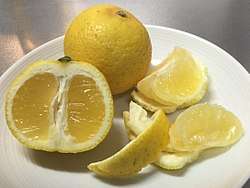Ōgonkan
Ōgonkan (黄金柑, "golden citrus") or Ki-mikan (黄蜜柑, "yellow mikan") are the common names for a small sized variety of Japanese citrus, whose rind is of a characteristic "golden" bright yellow color.
| Ki-mikan (黄蜜柑) or Ōgonkan (黄金柑) | |
|---|---|
 | |
| Ōgonkan grown in Ehime Prefecture | |
| Scientific classification | |
| Kingdom: | |
| (unranked): | |
| (unranked): | |
| (unranked): | |
| Order: | |
| Family: | |
| Genus: | |
| Species: | C. flaviculpus |
| Binomial name | |
| Citrus flaviculpus hort. ex. Tanaka | |
The variety has been published as the species Citrus flaviculpus by Chōzaburō Tanaka in his 160-species scheme, but this is considered an effort of a "splitter," as opposed to Swingle's classification system which is generally preferred in the West.
Alternate spellings (romanizations) include "Ougonkan"[1] or "Ogon-kan".[2] It has also been called "Golden orange" in Kanagawa Prefecture.
History
The variety has long been known in Kagoshima Prefecture as Ki-mikan (黄蜜柑, "yellow mikan") but, precise origins are unknown.[3]
According to one assertion, it has been known in Higashi-ichiki-chō (ja) and its neighborhood (now Hioki, Kagoshima) since the Meiji Period. Anecdotally in this Hioki area, it has been told that the variety was either introduced by the Jesuit Francisco de Xavier, or brought back from the Korean Peninsula during the campaigns in the late 16th century (Hideyoshi's invasions of Korea).. It has been suggested that the name "Ōgonkan" was dubbed by Harutarō Muramatsu (村松春太郎) who introduced the variety to Ehime Prefecture, but this too is poorly documented.
Fruit
The small fruit has a diameter of 4 to 5 cm, weighing 60 to 80 g.[4] The rind, which is bright yellow, can be peeled by hand but with difficulty.[5] It issues a distinct fragrance, and is considerably sweet tasting, with some balancing acidity. Harvested from February to April. Seedless (Self-incompatibility) traits have been observed.[6]
Its fragrances is similar to the Hyuganatsu, which is another bright yellow citrus that is larger-sized,[4] but somewhat sweeter by comparison. And like the Hyuganatsu, the white pith (albedo) may be eaten.[4]
The rind's cold-pressed oil has been studied for fragrance factors, and was found to contain limonene (roughly 80%), followed by the monoterpene Gamma-terpinene (10%), trans beta-farnesene, and myrcene,[7] showing similarity to Hyuganatsu's peel profile, though with quantitative differences in concentrations.[7]
Regional production
According to government (MAFF) statistics for FY2010, crop yield of the Ōgonkan totaled 137.3 t (metric tons) in all of Japan, with 108.2 t shipped to market, none of it classed as processed goods (i.e., juices, etc.) in the statistics. Kanagawa Prefecture produced 93.4 t, representing 68% of the national total, followed by Shizuoka Prefecture with 25.0 t (18%), Ehime Prefecture with 13.9 t, and Kōchi Prefecture with 5.0 t.[8] Major cultivating areas listed are Odawara and Yugawaracho (Kanagawa pref.), Numazu, Shizuoka, Uwajima, Seiyo, Imabari (Ehime pref.), and Kōnan, Kōchi.[8]
Hybrid crossing
The Ōgonkan was the pollinating parent for the hybrid cultivar Hime-Koharu (媛小春) developed by Ehime Prefecture, and was the seed parent of Shonan Gold developed by Kanagawa Prefecture.[1][2][4][9]
See also
Notes
- Shigematsu et al. 2008
- Manago et al. 2004
- Manago et al. 2004, p. 36. This source further cites: 岩政, 正男 (Iwamasa, Masao) (1976). 柑橘の品種 (Kankitsu no hinshu). 静岡県柑橘農業協同組合連合会. p. 229., 田中, 諭一郎 (Tanaka, Yuichiro) (1980). 日本柑橘図譜 続篇(Nihon kankitsu zufu zokuhen). 養賢堂. pp. 78–80., and 日本果樹種苗協会 (Nihon kaju shubyō kyōkai (2003). 特産のくだもの マンダリン類 (Tokusan no kudamono mandarin rui. 1. 日本果樹種苗協会. pp. 38–45.
- Choi & Sawamura 2001, p. 48
- Manago et al. 2004, p. 36
- Yamamoto, Kubo & Tominaga 2006
- Choi & Sawamura 2001
- 農林水産省(MAFF). "特産果樹生産出荷実績調査 (Tokusan kaju seisan shukka jisseki chōsa)". Retrieved February 2012. Check date values in:
|accessdate=(help) 都道府県別 平成22年産 (Citrus production statistics by prefecture, FY 2010) Excel - MAFF. "登録品種データベース (Register kind database)". Retrieved 2012-10-25. 媛小春(Hime-Koharu 17067)湘南ゴールド(Shonan Gold 11469) (English page links provided, but without any substantive description)
References
- Choi, Hyang-Sook; Sawamura, Masayoshi (2001). "Volatile Flavor Components of Ripe and Overripe Ki-mikans(Citrus flaviculpus Hort. ex Tanaka) in Comparison with Hyuganatsu (Citrus tamurana Hort. ex Tanaka)". Bioscience, Biotechnology, and Biochemistry. 65 (1): 48–55. doi:10.1271/bbb.65.48. ISSN 1347-6947. JGLOBAL ID:200902119536771254.CS1 maint: ref=harv (link)])
- Yamamoto, Masashi; Kubo, Tatsuya; Tominaga, Shigeto (2006). "Self- and Cross-incompatibility of Various Citrus Accessions". Journal of the Japanese Society for Horticultural Science. 75 (5): 372–378. doi:10.2503/jjshs.75.372. ISSN 1880-358X.CS1 maint: ref=harv (link))
- 山本雅史, 久保達也, 冨永茂人, 「カンキツにおける自家および交雑不和合性」 園芸学会雑誌 75巻5号(2006年)
- In Japanese with English abstracts
- 真子, 正史; 鈴木, 伸一; 鈴木, 誠; 浅田, 真一 (2004). カンキツ新品種'湘南ゴールド. 神奈川県農業総合研究所報告 (in Japanese). 145: 35–41. JGLOBAL ID:200902245650237565. (w/English title and abstract) Agriknowledge (with PDF link); Agri-kanagawa (pdf)
- =Manago, Masafumi; Suzuki, Sin-ichi; Suzuki, Makoto; Asada, Shin-ichi (2004). "Kankitsu shin hinshu shōnan gōrudo (A New Citrus Cultivar 'Shonan-gold')" (agris). Bulletin of the Kanagawa Prefectural Agricultural Research Institute). 145: 35–41. ISSN 0388-8231.CS1 maint: ref=harv (link)
- 重松幸典; 喜多景治; 薬師寺弘倫; 石川啓; 石川啓 (March 2008). "カンキツ新品種'媛小春'について". 愛媛県立果樹試験場研究報告. 22: 5–8., JGLOBAL ID:200902281400290696, (pdf)
- =Shigematsu, Yukinori; Kita, Kageharu; Yakushiji, H.; Ishikawa, K (March 2008). Nakata, H. "The New Citrus cultivar'Himekoharu'". Bulletin of Ehime Fruit Tree Experiment Station. 22: 5–8. ISSN 0389-2867.CS1 maint: ref=harv (link)
External links
- Registration kind database (MAFF cultivar registration database. Available in English with limited information.